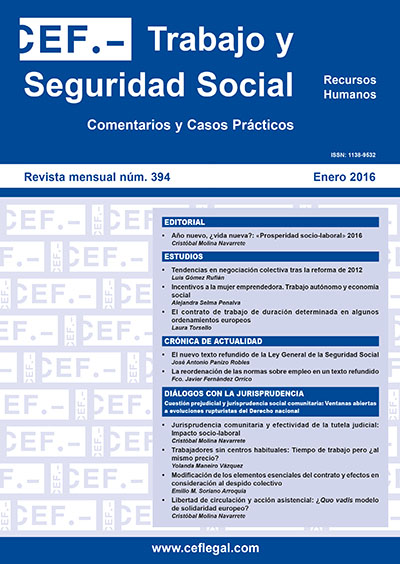Structural trends in collective bargaining system following the reform of 2012
DOI:
https://doi.org/10.51302/rtss.2016.2006Keywords:
collective bargaining, labour market reform, centralization, coverage, wagesAbstract
As it is well known, the reform of collective bargaining constitutes one of the labour reform's cornerstones implemented in Spain in 2012 which designed a set of measures that will make «collective bargaining will be a tool, not an obstacle, to adapt labour conditions to the specific circumstances of the business conditions». In this sense, the labour reform of 2012 established the priority of firm-level agreements over industry-wide ones, substantially eased the situations where they may not be applied and modified the rules about ultraactivity. So, these changes have great potential to impact on over issues such as the degree of centralization of the system, his level of coverage, speed of renegotiation of the agreements or the evolution of wage increases, so that, once 2013 data are definitely closed, that is to say, two years from the adoption of law, it is time to make a first preliminary analysis of its effects.
Downloads
References
Calmfors y Driffill [1988]: «Bargaining structure, corporatism and macroeconomic, performance», Economic Policy, núm. 6, págs. 13 a 61.
Cruz Villalón, J. [2013]: «Impacto de las reformas laborales sobre la negociación colectiva», Relaciones Laborales: Revista Crítica de Teoría y Práctica, núm. 12, págs. 199 a 214.
Dolado, J. J. [2012]: «The pros and cons of the latest labour market reform in Spain», Spanish Labour Law and Employment Relations Journal, vols. 1-2, págs. 22-30.
Jaumotte, F. [2011]: «The Spanish labor market in a cross-country perspective», IMF Working Paper, WP/11/11, enero, págs. 7-9.
Jimeno, J. F. y Thomas, C. [2012]: «La relación entre el grado de centralización de la negociación colectiva y la tasa de desempleo: Nuevos resultados», Boletín Económico del Banco de España, febrero, págs. 59 a 66.
Mercader Uguina, J. R. [2013]: «Análisis factorial y mecanismos de articulación jurídica de la estructura de la negociación colectiva», RTSS.CEF, núm. 362, págs. 5 a 50.
— [2003]: «Modelos metodológicos de la ciencia jurídica y su impacto sobre el derecho español del trabajo: Una aproximación», en AA. VV., Homenaje a Luis Rojo Ajuria, Escritos jurídicos, Universidad de Cantabria, págs. 411 a 423.
Rodríguez Fernández [2000]: La estructura de la negociación colectiva, Valladolid: Lex Nova.
Rodríguez-Piñero, M. [2011]: «La difícil coyuntura del Derecho del Trabajo», Relaciones Laborales: Revista Crítica de Teoría y Práctica, núm. 2, págs. 75 a 87.
Simón, H.: «La negociación colectiva y la estructura salarial en España», Papeles de Economía Española, núm. 124, págs. 214 a 228.
VV. AA. [2007]: (Ruesga, S.: coord.), Análisis económico de la negociación colectiva en España. Una propuesta metodológica, Ministerio de Trabajo y Asuntos Sociales.


















